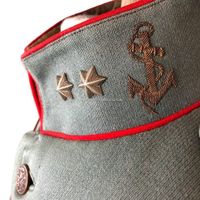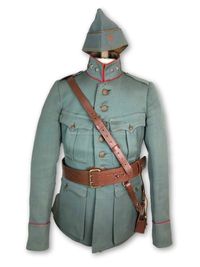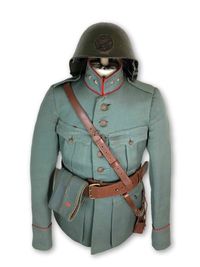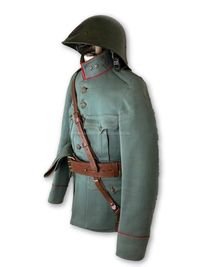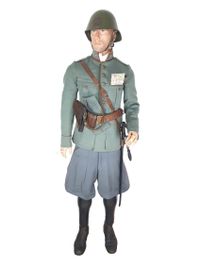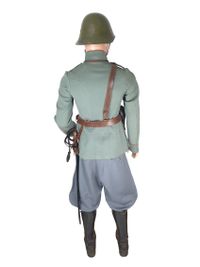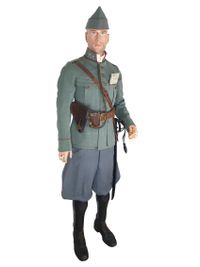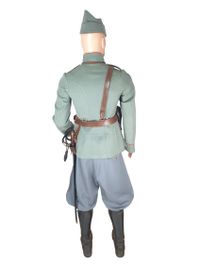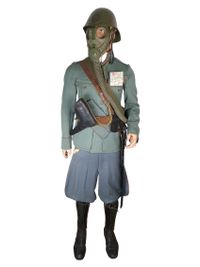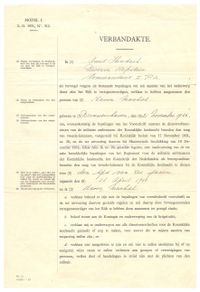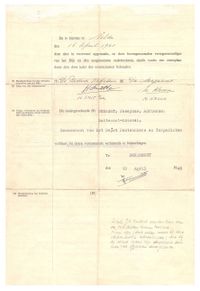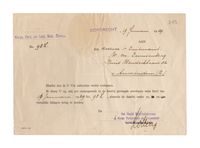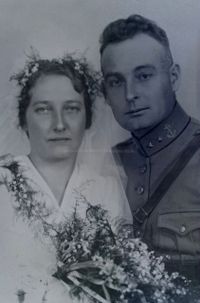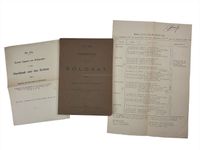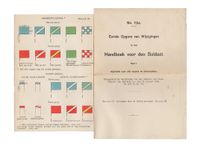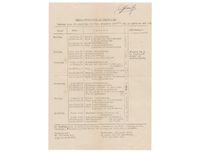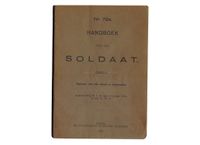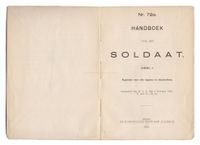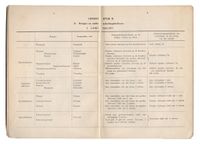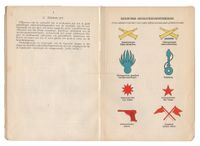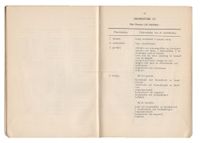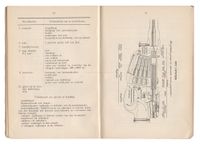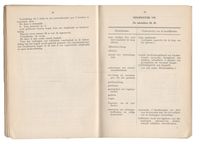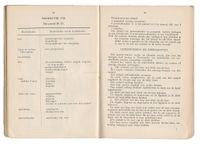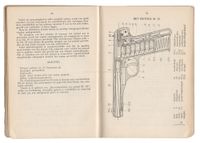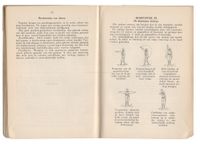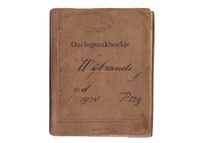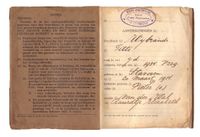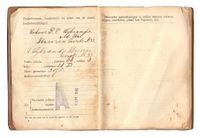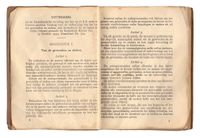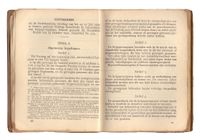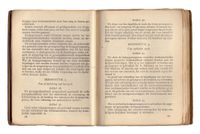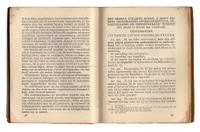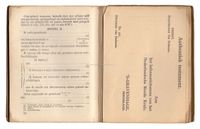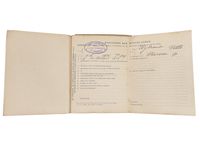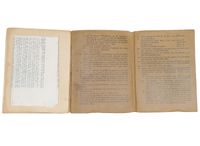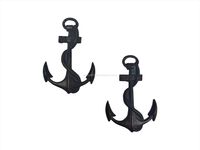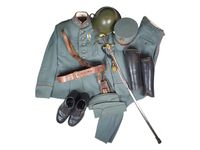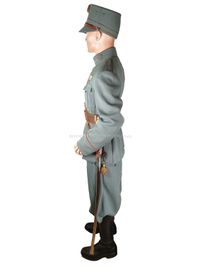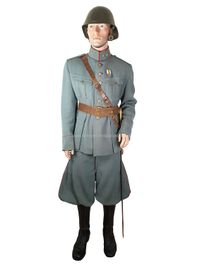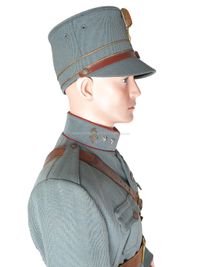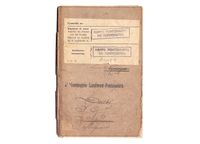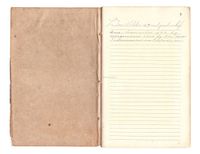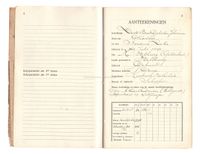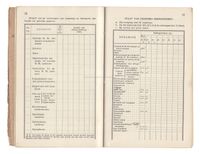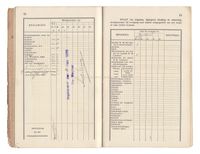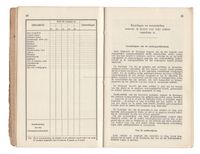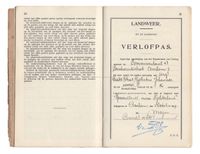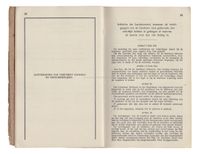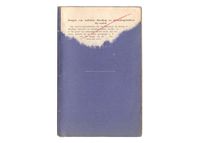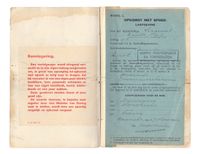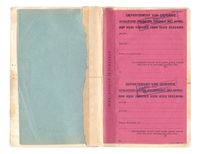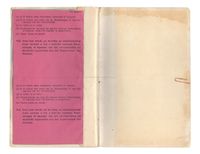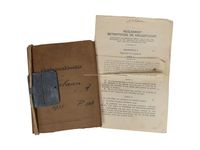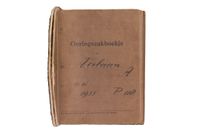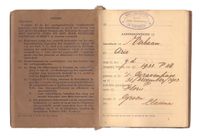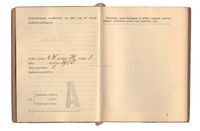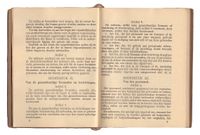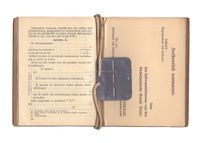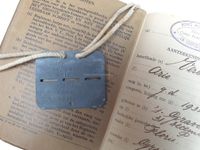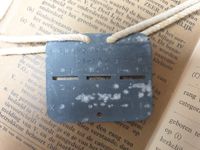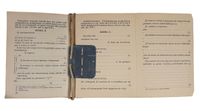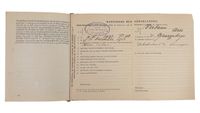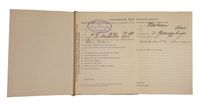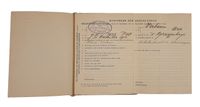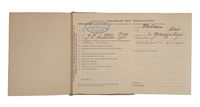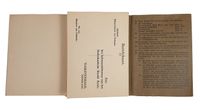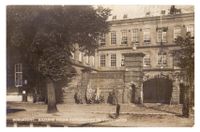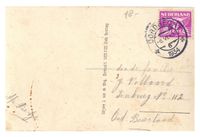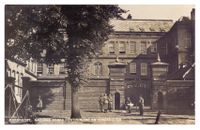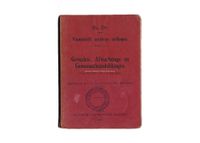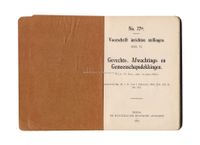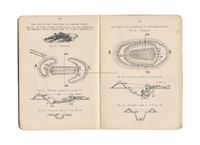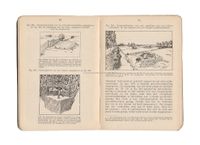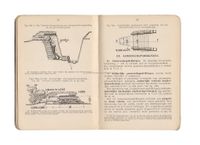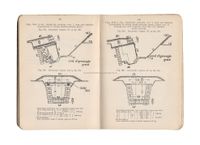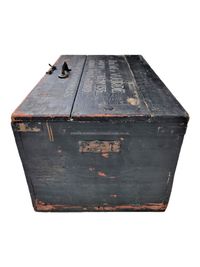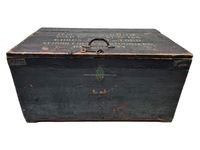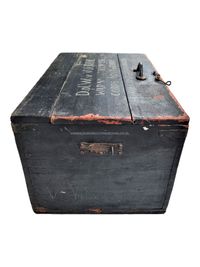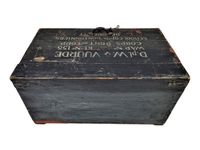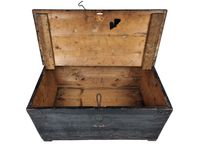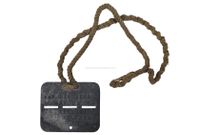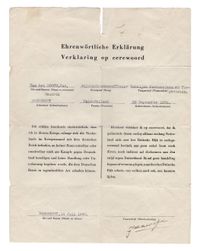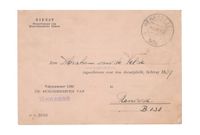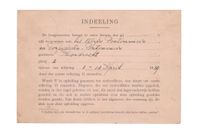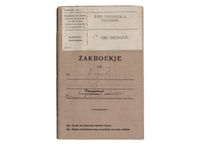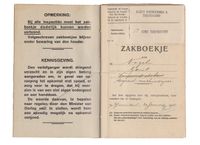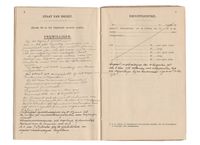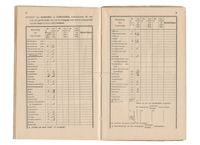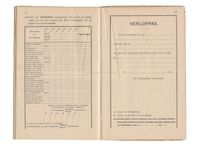The "Korps Pontonniers en Torpedisten" in Dordrecht.
Regarding the Corps of Pontonniers and Torpedisten:
( Or Army Maritime Engineers Corps ).
The Pontonniers, throughout history, have been under the artillery branch. This explains the red trim on the collar of the pontonnier uniform, which is also seen on artillery uniforms. The task of the Pontonniers was to construct bridges over waterways to facilitate the movement of armies. Later, the Torpedisten were added to the Pontonniers. Their task was to lay or remove underwater mine barriers, hence the name Torpedisten derived from the word "torpedo." It wasn't until 1927 that the Corps of Pontonniers and Torpedisten fell under the Engineering branch as one corps. The Depot for Pontonniers and Torpedisten was located in Dordrecht. Part of it was stationed at the Benthienkazerne on the Buiten-Walevest, which also housed the training company, or the school for Pontonniers and Torpedisten. Just a little further down the Buiten-Walevest was the Pontonnierskazerne, which still exists to this day. The rest of the garrison during mobilization was spread across various locations in Dordrecht, including several schools in Krispijn. There were also Pontonniers stationed in Papendrecht. In May 1940, the strength of the garrison was almost 1500 men, but about 20% of them had only been called up days before the outbreak of the war and were not yet ready for active service. These were the youngest recruits from the school company. The Pontonniers had little to no training in warfare and weapon deployment, as most of their attention during their training was focused on their specialized engineering tasks. Nevertheless, during May 1940, the Pontonniers and Torpedisten displayed surprising bravery and tactical acumen. *1 *
The Pontonniers Uniform:
Below you can see a Pontonniers uniform from the mobilization period in the Netherlands. It is a field gray jacket with the characteristic anchor emblem of the Pontonniers displayed on the collar, along with two red trims above and below it. The two stars on either side indicate that the jacket belonged to a First Lieutenant of the Pontonniers. The jacket has four pockets, and the fabric clearly shows that it is an outer cut uniform, as opposed to the coarser wool uniform typically worn by enlisted personnel and often by non-commissioned officers.
Officers were entitled to a reimbursement for the purchase of an "buitenmodel" uniform. They also had a higher salary to cover the costs of such a purchase. This is one of the reasons why there are still many "buitenmodel" uniforms found today, while there are very few coarse wool uniforms. The latter had to be turned in by Dutch soldiers during the occupation and were eagerly reused and converted by the Germans into German-style uniforms. The "buitenmodel" uniforms often remained in private possession. This jacket is an example of that. Unfortunately, the jacket does not have a name attached to it. In the photos below, two display options can be seen: one with the field gray cap and one with a helmet. In many cases, officers could also wear a kepi.
The field gray cap with gold trim was for officers and was the same for every service branch or specialty. The cap features an Orange Lion emblem.
The next photo shows the Dutch helmet with its characteristic lion plate. The helmet was generally the same for all soldiers and did not have any characteristic features indicating the rank of an officer, as can sometimes be seen in other countries. The helmet would be worn in combat situations. Additionally, a "Sam Brown" belt with saber or cutlass carrier can be seen. The belt was designed for officers and was of the same model as those worn by British officers. The saber or cutlass carrier, as the name suggests, provided a place to carry a saber or cutlass.
Update May 12, 2020:
We have successfully set up a complete mannequin. Below are the photos:
The mannequin represents a First Lieutenant of the Corps of Pontonniers and Torpedisten in May 1940. In the first four photos, he is wearing his combat helmet. The lieutenant has inserted a map of Dordrecht into his left breast pocket. Over his uniform, he is wearing the standard "Sam Brown" belt worn by officers of the pre-war Dutch army. Attached to the belt, he has various items. Firstly, his M25 pistol holster, which would normally contain the FN Browning pistol. This was a standard weapon among Dutch officers as well as non-commissioned officers. Pontonnier officers were often equipped with older revolvers. Next to his holster is the magazine pouch, which holds two magazines. On his hip, he carries the cutlass ( Klewang ) . Although this weapon was primarily used within the Royal Dutch East Indies Army (KNIL) as a means of navigation through the jungle, the cutlass had a more traditional character in the European Dutch army. Nevertheless, during the May 1940, many Dutch officers and non-commissioned officers wore the cutlass. There is even a story known of a Dutch soldier who used it to fight German soldiers here on the Grebbeberg.
Upon closer examination, we can see that the trousers have a different color than the jacket, which was not uncommon. Usually, the outer cut uniform was purchased as a set, and its color would match. However, the trousers were often subject to more wear and tear, which sometimes required the purchase of additional trousers. It was not always guaranteed that the same color trousers could be acquired. These trousers also have a red trim, just like the jacket, which is customary for officers. The lieutenant is wearing gaiters over his trousers, while enlisted personnel typically wore puttees or leg wraps. Beneath his gaiters, we see black shoes. These were often privately purchased by the soldiers, for which they received a reimbursement.
In the photos below, you can see that the officer has exchanged his helmet for his field cap. Additionally, he is holding an open pack of Dutch Amateur cigarettes in one hand. In the other hand, he is holding one of the cigarettes. The mobilization period was a time when almost every adult man smoked, either a pipe or cigarettes.
Update July 22, 2021:
Several adjustments have been made to the composition of the above mannequin. A study of various photos of the Corps of Pontonniers and Torpedisten revealed that the (sub)officers of this corps were generally equipped with the M1873 revolver instead of the M25 pistol. Therefore, the M25 holster set has been replaced with an M1873 revolver set. Additionally, a gas mask pouch with a gas mask (Type G) has been added to the mannequin. Finally, a camera and a pair of glasses have been included to enhance realism. You can find the photos below.
Contract of the Corps of Pontonniers and Torpedisten with the signature of cantonment commander Josephus Adrianus Mussert.
(Click on the photo to enlarge.)
The document below is an "Verbandakte" (employment contract) for a military member of the Corps of Pontonniers and Torpedisten. The military member signs this certificate for a period of 6 years. Interestingly, the military member signed this document just three weeks before the start of the war in the Netherlands. What is even more intriguing is that Lieutenant-Colonel Mussert has signed the document.
Lieutenant-Colonel Mussert was the depot and cantonment commander of the Corps of Pontonniers and Torpedisten in Dordrecht and initially led the Dutch troops in Dordrecht. During the conflict, there was a paranoia of betrayal among the troops, including some officers, which led to a lack of trust in Mussert. He was frequently accused of providing information to the Germans. Mussert was the brother of Anton Mussert, leader of the NSB ( National Socialist Movement ) , and for many, this association was enough to assume that Mussert must have been a traitor.
When Dordrecht was evacuated, Mussert, like many other military personnel in Dordrecht, moved to Sliedrecht. Here, Dutch officers, First Lieutenant Kruithof and Reserve Captain Bom, attempted to apprehend Mussert, but it didn't go as planned. Lieutenant Kruithof shot Mussert, who later died in the hospital in Gorinchem.
Pontonniers document for First Lieutenant Leeuwenberg.
Below is an interesting and official military document from the Corps of Pontonniers and Torpedisten in Dordrecht. It is addressed to Reserve First Lieutenant Leeuwenberg. It was sent back along with the military pocketbook to the respective military member, and there is also a request to send a document back to the mobilization bureau. Perhaps the lieutenant was called upon for mobilization duties. Lieutenant Leeuwenberg was promoted to Reserve Lieutenant of the Artillery on December 3, 1921, and promoted to Reserve First Lieutenant on December 3, 1925, and assigned to the Corps of Pontonniers and Torpedisten. It is unknown whether this lieutenant was present in Dordrecht during the May days of 1940.
Original negative of the wedding photo of Reserve First Lieutenant J. van der Houwen.
Below is the wedding photo of Knight of the Military Order of William, 4th class, Reserve First Lieutenant J. van der Houwen, seen in his uniform. Lieutenant van der Houwen was an officer in the reserve detachment on May 10, 1940. While cycling towards the barracks, he was already being fired upon by German paratroopers. He was the first officer to arrive at the barracks and found the troops unprepared. With about twenty men and limited ammunition, he set out towards Krispijnse weg to engage in combat with the German paratroopers who had landed in the meadows. The railway engineer troops at Villa Weizigt and the station were already in battle with these paratroopers and their decisive actions had created the conditions for what would later become the destruction of almost an entire German parachute company.
When the fight with the paratroopers of 3./FJR 1 was mostly over and a significant part of the company was taken prisoner, wounded, or killed, Lieutenant van der Houwen, along with about ten pontonniers and torpedisten, proceeded to clear the Bosch van de Roo of any remaining paratroopers. This was certainly not without risk as they were constantly under fire from friendly troops who mistook them for Germans. Suddenly, paratroopers emerged, and German Leutnant Schmelz came forward, stating that he and his troops wanted to surrender.
In this way, Lieutenant van der Houwen's group initially took about 30 German prisoners of war, and later, about ten more. For his courage, leadership, and loyalty, Lieutenant van der Houwen would be awarded the Knight of the Military Order of William, 4th class, after the war. *3
Soldier's Handbook with Attachments.
Here you can see a Soldier's Handbook with various attachments. What is particularly interesting about this handbook is the attachment of the training schedule for the conscript sergeant from 1937 III, dated April 19th - May 21st, 1938. The schedule lists the lessons that a corporal undergoing training to become a sergeant had to follow. The names of the military personnel who conducted these lessons are listed at the bottom of the schedule:
1. Lieutenant Fransen 2. Adjutant Steeds 3. Sergeant Balt 4. Sergeant Wieringa 5. Sergeant Major Troost 6. Sergeant Roubos.
The Soldier's Handbook is a standard publication of the Royal Military Academy. It contains information regarding ranks, insignia, weapon usage, and maintenance. Often, there is a name and unit written inside the cover of such booklets, but in this case, that is not the case.
War pocketbook ( oorlogszakboekje ) of conscript private Titte Wijbrands.
Here you can see a war pocketbook ( or oorlogszakboekje ) of conscript private Titte Wijbrands. He was called up as an ordinary conscript to the Corps of Pontonniers and Torpedisten in 1934. Titte was born on March 20, 1914, in Stavoren. His father Pieter Wijbrands was a stoker. It is possible that his son also became a stoker and was therefore assigned to the Corps of Pontonniers and Torpedisten. The corps had a rich presence of military personnel with a background in maritime affairs. The service record of conscript private Wijbrands is unknown. It is unclear whether he was in active service in May 1940, but it is highly likely.
The war pocketbook was issued to every military personnel. Along with it, the soldier was also given an identification tag to wear around the neck. The front of the identification tag displayed the birthplace, birth date, and conscription number of the soldier, while the back showed their name. The pocketbook contained additional information. On the first page of the pocketbook, there were general details about the soldier and their parents. The second page included some personal information of the soldier, such as clothing sizes, blood type, and any vaccinations. Page three provided space for notes about injuries, death, and burial location. Pages 4 to 51 contained regulations regarding the rights and obligations of the soldier when wounded, captured as a prisoner of war, or employed by an enemy power. Following that, there were pages with templates for recording a will. Finally, at the back of the pocketbook, there were message cards concerning injured, sick, or deceased individuals from the Royal Army in a state of war. These were to be filled out and sent to the information bureau of the Red Cross. If the soldier were to fall in combat, the pocketbook and identification tag would be collected by the Red Cross for processing, burial, and potential repatriation of the fallen.
What is remarkable about this war pocketbook are the stamps of the Corps of Pontonniers and Torpedisten - School Company Pontonniers. Since the training depot of the Corps of Pontonniers and Torpedisten was located in the Benthien Barracks in Dordrecht, and the school company was also housed in this barracks, Pontonnier Titte Wijbrands definitely spent the time of his training as a pontonnier in Dordrecht.
The pocketbook also contains a document with songs for military gatherings.
Below you can see an original set of collar insignia for a soldier in the Corps of Pontonniers and Torpedisten. These emblems were worn on each collar of the "coarse fabric" uniform or the prototype uniform to indicate that the soldier was part of the Corps of Pontonniers and Torpedisten. Embroidered collar insignia could only be found on the collar of the "buitenmodel" uniform.
First Lieutenant, Corps of Pontonniers and Torpedistsen.
Here you can find the uniform of a First Lieutenant of the Corps of Pontonniers and Torpedisten. The uniform has some differences compared to the First Lieutenant previously posted on this page. The jacket, trousers, two peak caps, and kepi all belonged to the same person. The shoes, gaiters, belt, saber, and helmet have been added to complete the ensemble.
The jacket still has a name label, but unfortunately, the name is no longer readable. The First Lieutenant of the Corps of Pontonniers and Torpedisten depicted at the top of the page is equipped for field or combat. With this uniform, the choice has been made to depict a wearing style for a more ceremonial occasion. Interestingly, the uniform is quite large in size. While it is usually a problem to fit Dutch uniforms on a mannequin, this uniform is actually still a bit too big. This is not common for Dutch uniforms, suggesting that the wearer of the uniform was a large man for his time. For the portrayal of the uniform, a photo from the image bank of the Regional Archive Dordrecht was used as inspiration: This photo shows the command transfer from Lieutenant-Colonel Valliant to Lieutenant-Colonel Mussert at the Pontonniers barracks. See the photo.
On the right side of that photo, there is a First Lieutenant of the Corps of Pontonniers and Torpedisten with a saber in hand. He is wearing the so-called "Jeneverkruis" - a medal for faithful service for officers.
The first three photos above provide a nice representation of the First Lieutenant wearing his "Kepie". The Corps of Pontonniers and Torpedisten did not have a regimental number on the cap. Instead, they wore a Dutch lion on the cap or side cap. The officer wearing the saber on the officer's belt is carrying a Yzerhouwer saber. The Klewang sword was generally worn in the field and also during May 1940, while the saber was worn more for ceremonial occasions.
On the chest of the uniform, there is an Officer's Cross for faithful service. In this case, it represents 25 years of service. The cross was also known as the "Jeneverkruis" because, traditionally, a glass of Jenever (a Dutch liquor) was shared during its presentation. The fourth photo shows the officer wearing his helmet. This photo indeed bears the most resemblance to the photo from the regional archive. In the photos below, a closer look is taken at the jacket and cap. Here, you can clearly see the two stars on the collar of the jacket, indicating the rank of First Lieutenant, as well as the anchors of the Corps of Pontonniers and Torpedisten.
Military Pocketbook of Sergeant P.G.J. Duits - Landweer ( Reserve )Pontonniers.
Below you will find the Military pocketbook of Sergeant Petrus Gijsbertus Johannes Duits. Mr. Duits was born on July 20, 1890, in Valburg (Gelderland) as the son of Nicolaas Duits and Berdina Laks. He was a skipper by profession. On March 3, 1910, Petrus Duits was assigned to the Corps of Pontonniers as a conscript of the 1910 selection from the municipality of Valburg. At that time, the corps was still an independent corps under the Artillery, until 1927. His service record in the registries does not make it clear whether he enlisted in Dordrecht. However, this is likely since Dordrecht had been the station for maritime engineering soldiers since the 16th century. Between his enlistment date and 1914, he went on several leaves and returned each time. On August 1, 1914, he returned from a major leave during the mobilization call-up. It was necessary to maintain the neutrality of the Netherlands. On October 31, 1914, Mr. Duits was promoted to corporal, and on August 31, 1915, he became a sergeant. As of August 1, 1917, Mr. Duits transferred to the 2nd Landweer Company of Pontonniers in the Landweer District Nijmegen. A year later, on June 11, 1918, he transferred to the Landweer District Arnhem I. On October 1, 1919, Mr. Duits went on leave again as part of the demobilization. His pocketbook indicates that as of September 1, 1922, due to reorganization, he transferred to the Corps of Pontonniers and Torpedisten. In 1925, he received a stamp for the return of military goods in his pocketbook. Presumably, he still held some form of reserve role afterward. Interestingly, there is a travel booklet with vouchers for transportation via state reimbursement accompanying the pocketbook. The document indicates that in 1931, he was still part of the supplementary reserve. When the supplementary reserve of his weapon and selection took place by public notice, he could use the travel vouchers in the booklet to travel for free to his mobilization destination. This was the Pontonniers barracks in Dordrecht. The booklet is signed by a captain on March 27, 1931.
The travel voucher booklet accompanying the aforementioned pocketbook:
War pocketbook and identification tag for the Corps of Pontonniers and Torpedisten.
In the photos below, you can see the war pocketbook and identification tag of Arie Verbaan. Arie Verbaan was born on December 31, 1913, in The Hague. He was the son of Floris Verbaan and Clasina Groen and lived at the Urkschestraat number 2 in Scheveningen. After completing his education in primary school, he became a fisherman by profession. On February 16, 1933, Arie was drafted as a regular conscript into the Corps of Pontonniers and Torpedisten. He was assigned to the School Company of the Pontonniers in Dordrecht. On July 29, 1933, he went on extended leave. On September 13, 1937, he returned and after attending another exercise in Epe between September 20 and 24, he went on extended leave again on September 29. On August 29, 1939, as part of the General Mobilization, he returned. He remained in service until the outbreak of the war. His service record does not indicate his mobilization destination. Since there were over 1500 Pontonniers and Torpedisten in Dordrecht during May 1940, it is likely that Dordrecht was his destination. It is certain, however, that he experienced the events of May 1940 as a soldier because on May 24, 1940, he went on extended leave for the last time.
The war pocketbook is of the same type as the previously described war pocketbook of Titte Wijbrands. However, this war pocketbook includes his identification tag. The identification tag is made of zinc. It has his name, date of birth, place of birth, conscription number, and military unit stamped on it. The tag was worn around the neck with the help of a cord. In the war pocketbook, you can once again see the stamps of the School Company of the Pontonniers of the Corps of Pontonniers and Torpedisten.
Postcards Corps of Pontonniers and Torpedisten.
The below postcards are published by J. de Weg. They are civilian postcards featuring images of the Benthienkazerne of the Corps of Pontonniers and Torpedisten on the Buiten-Walevest. Both cards were sent in 1934.
Field postcard Pontonnier - March 11, 1940.
Below you can see a field postcard that was written by a pontonnier, presumably to his sister. The card was written by Pontonnier H v.d. Bosch of the 2nd depot company (room 5). He writes that he missed the train from Rotterdam to Dordrecht. The next day, he continued his journey and had to report to the commander, who told him that he should leave earlier from now on. He further writes that he is doing well.
Regulation for Establishing Fortifications - Corps of Pontonniers and Torpedisten.
Below you can see a regulation for establishing Fortifications. The regulation was issued by the Royal Military Academy in Breda in 1933. This regulation is stamped with a stamp of the Corps of Pontonniers and Torpedisten. It was used for the training of Pontonniers and Torpedisten. The regulation describes and illustrates how to construct various types of cover and positions.
"Kribbekist" ( foot locker ) Corps of Pontonniers and Torpedisten.
Below you can see a so-called "Kribbekist". The Kribbekist was a lockable wooden box provided to the soldier. In this box, they could store both personal belongings and their military equipment. The krib box was usually placed at the foot of the bed or under the bed and was intended for use in the barracks. For privates and non-commissioned officers, Kribbekisten were usually of a standard model and were often painted black or green. The Kribbekist is approximately 58 cm long, 35 cm wide, and 28 cm high. Officers usually had a longer clothing box painted green. The box in this photo belonged to Conscript W. v. Vuurde with the conscription number 156. What makes this box particularly special is that it belonged to a soldier who served in the Corps of Pontonniers and Torpedisten in Dordrecht. Clearly visible on the box is:
W. v. Vuurde
Wap. No KL.No 156
Corps Pont. en Torp.
Schoolcomp. Pontonniers
Dordrecht.
The box was also reused. It was initially green, and although the letters are difficult to read, it can still be deciphered that the box originally belonged to Mr. W. Tempelaar Litz. The latter served in the 4th Depot Battalion - 7th Company. Unfortunately, no further information has come to light about either of these soldiers. It is difficult to determine without a date of birth. Nevertheless, this Kribbekist is a beautiful piece of history related to the Corps of Pontonniers and Torpedisten and the city of Dordrecht.
Identification tag Gradus P. van den Berg - Corps of Pontonniers and Torpedisten.
Below you will find the identification tag of the private Gradus P. van den Berg. Van den Berg was born in Renkum on May 25, 1918. He served in the Corps of Pontonniers and Torpedisten in the conscription of 1938. His conscription number is P-27. This is a punched tag. Previous versions of the name tag were written with acid. Unfortunately, further information cannot be provided at this time as the request for the service record still needs to be made.
Oath Declaration of Adjutant van het Hoofd - Corps of Pontonniers and Torpedisten.
Below you will find an oath declaration of Adjutant Jan van 't Hoofd. The Adjutant fought alongside the Corps of Pontonniers and Torpedisten in May 1940. The oath declaration was a statement in which the Dutch military personnel promised not to take up arms against Germany or German forces any longer. As a result, the Dutch military personnel who signed this declaration were not treated as prisoners of war.
Classification for the Conscription Card.
Below you will find the classification card for conscript Mr. Abraham van de Velde. He was registered for the conscription of 1939. The enrollment took place between 1 and 10 April 1939 with the Corps of Pontonniers and Torpedisten in Dordrecht. The card was issued by the mayor of Renesse.
Pocketbook Gerrit Nagel - Corps of Pontonniers and Torpedisten.
Below you will find the military pocketbook of Gerrit Nagel, born on August 1, 1903, in Winschoten. At the time of the pocketbook's creation, Gerrit was unmarried and worked as an electrician. On May 12, 1922, he voluntarily enlisted as a combat engineer for a period of four years. He was registered for the conscription of 1923 in the municipality of Winschoten. On March 4, 1924, Gerrit was transferred to the Corps of Pontonniers and Torpedisten. He became a Torpedist Stoker on May 10, 1924, and was promoted to Corporal Stoker on August 10, 1925. On March 17, 1926, Gerrit reenlisted for a year, and then again on February 10, 1927, for a period of four years. On March 15, 1928, he was promoted to Corporal Machinedriver. In 1928, he was awarded the Watersnood Medal. Finally, on August 10, 1931, he was promoted to Sergeant Machinedriver, and on May 2, 1932, Gerrit was voluntarily connected to the army for an indefinite period of time. The last remarks in the pocketbook were written on December 18, 1933. Therefore, Gerrit Nagel served with the Corps of Pontonniers and Torpedisten at least until 1933.
I am always searching for Pontonnier-related items from the time of mobilization or May 1940.
Do you have any examples of such items? I would be happy to include them the collection! You can email them to info@dordrechtindeoorlog.nl.
©2017-2024 :Https://www.Dordrechtindeoorlog.nl: ( There is a copyright on the content of this website. This content is not to be shared, duplicated or published withouth the explicit permission of the author of this website. If you have any requests you can email to: Info@Dordrechtindeoorlog.nl or look on : www.dordrechtindeoorlog.nl/termsofuseforthecontentonthiswebsite.
*1 Source: Zuidfront-Holland1940 - Kantonnement Dordrecht.
*2 Source: The green books series of the museum 1940-1945 Dordrecht, deel 5, 6, 7, 8 Pontonniers, Mineurs, Sappeurs en Spoorwegtroepen.
*3 Source: Zuidfront-Holland1940- Dordrecht 2e fase.

